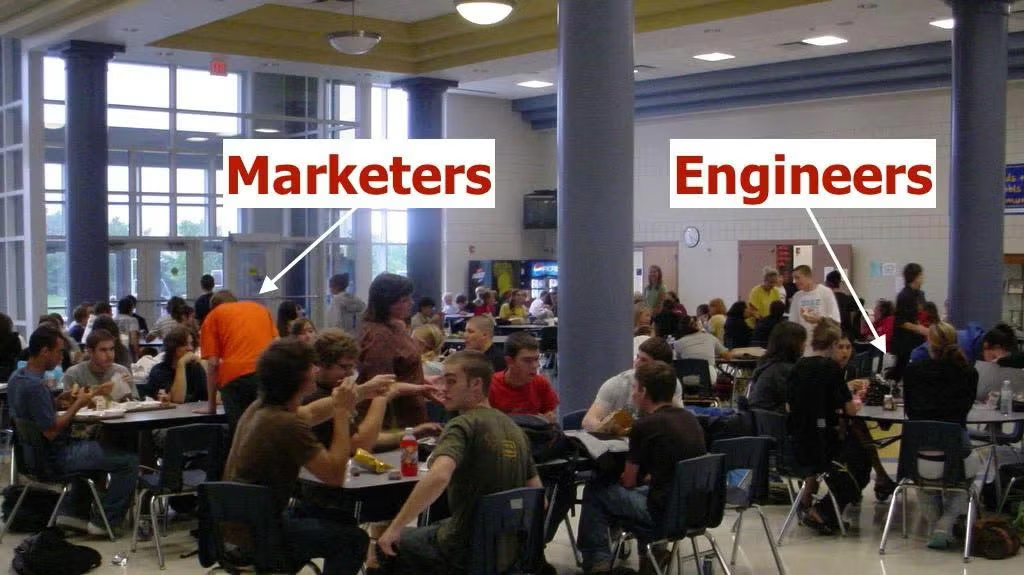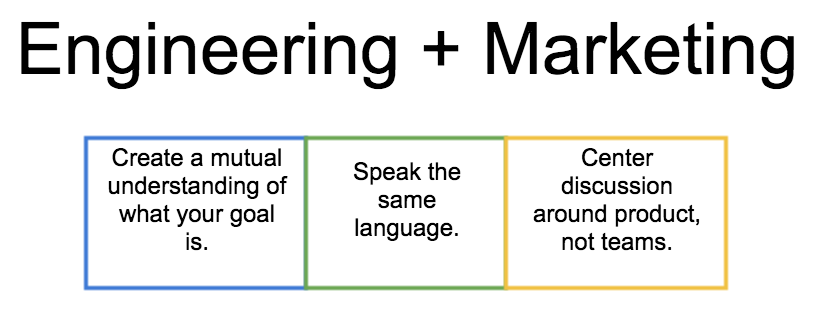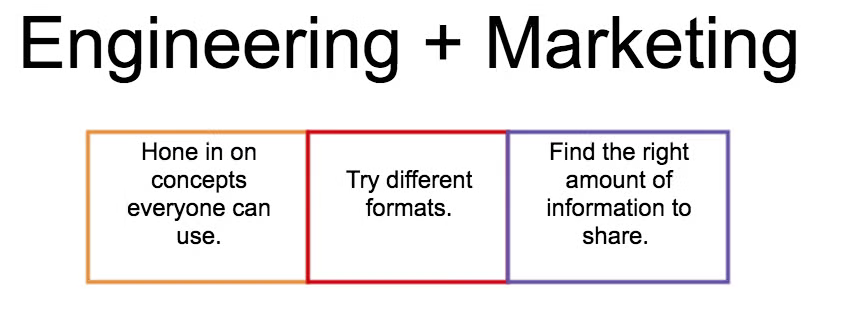In Tina Fey's seminal classic Mean Girls, the regimented cliques divide the cafeteria. There's band geeks, jocks, nerds, burnouts — and everyone hates each other, and everyone thinks they're better than everybody else. It's enough to make you want to eat alone, by yourself, in the bathroom.

[Source]
And while it does get better after high school, some things don't seem to change. That's right, we're talking about the understanding gap between marketers and engineers — a tale as old as time. Engineers think marketers are jargon-fueled and don't understand what's actually possible when it comes to building product, and marketers think engineers are jargon-fueled and don't pay attention to what customers want. Needless to say, they don't eat lunch together.

[Source]
But what if they shared more meals? What would they learn from each other, and how could it help their companies? Not only can marketers and engineers benefit from spending more time together, the belief that they just don't get along is being debunked all over the place. Marketing has more to do with engineering than ever before, and rapidly iterating software products need marketing to help them shine in 2.0, 3.0, and beyond.
From building a better product to building a better company, smoothing out any wrinkles between marketing and engineering will do a lot for your business. And that means cutting through everyone's jargon and focusing on building an amazing product, together.
Engineers who work with marketers make better products
While engineers understand the backend and frontend of the product, marketers understand what makes people click the "buy" button. And their deep knowledge of customers — what they want, what they do, how many dogs they're likely to own — can influence your product, especially when your product is software.
Business and personal software, game apps, operating systems — whatever you're making — are all deeply shaped by the people who use it. Sure 2.0 versions fix bugs and upgrade compatibility, but they also introduce or remove features and improve the UX, all of which relies on a solid understanding of how customers are actually using the product. Developers need to know what customers think and what they do with the product to get those upgrades right.
VP of platform ecosystem at HubSpot, Scott Brinker, writing about the similarities of engineers and marketers, says, “Understanding what the customer truly wants and values is given top priority in the development process. Developers and customers (or product owners on their behalf) [might] meet daily to evolve the product vision together.”
"This can be especially true for startups," says Robbie Mitchell, Knewton’s Head of Marketing and Communications, "who need to test product-market fit".
“Marketing is all about testing what works and what doesn’t,” Mitchell says. “So you can either build your product and test it at the same time, or build it and sit around while marketing catches up."

So how can you make sure you get at the good stuff, (and not just have marketing do an info dump on engineers), when it's time for everyone to sit at the table together over creamed corn and a carton of milk? Here's your step-by-step guide:
1. Get to a mutual understanding of what your goal is. Obvious as it seems, SO OFTEN teams don't have a shared goal. Either because their goals are actually different or because everyone is so heads down cranking out tasks that there is no time to acknowledge the end goal. Goal-setting should start at the top, but if it doesn't, sitting down and talking about what you think your teams' goals are is a great start to mutual understanding.
We at Gliffy have experienced the pain of not seeing the big picture first hand, which is why we're currently hard at work creating a new tool that will help solve this age-old problem. Curious? Get more info here.
2. Speak the same language. Every specialized field, like marketing, or engineering, is couched in jargon. It's useful to be able to talk to your colleagues using shorthand and acronyms, but avoid overusing them when in mixed company. Don't assume people just know, (this goes for both marketing and engineering). Instead, provide explanations of basic terms and concepts, and encourage people to ask and answer questions. And wherever possible, diagram or draw out concepts. Everyone speaks visual and having a diagram will eliminate a lot of confusion.
3. Center discussion around product, not teams. Here again, having a shared goal will help immensely because rather than pitting teams against each other, everyone can work towards what's mutually beneficial to all. Instead of focusing the discussion around team needs, ask what is needed to make the product better? How can we improve UX? After all, this is what you're really trying to get at when you say my team needs x, my team wants y, my team has to do z, but it's a much more useful conversation if you talk about working towards your joint end goal and not just what either team wants.
Marketers who work with engineers create smarter campaigns
Senior VP of marketing and commercial strategy at JetBlue, Marty St. George, has said that his engineering degree helps him solve problems at his job. That's because Marketing and advertising have left the “artistic genius” types behind — now you have to be able to work with software, read data, and be digitally savvy as well as good at creating content.
And that means that marketers who can think like — and interact with — engineers are going to be better at their jobs. "When an issue comes up,” he says, “my first thought is: How much data can I gather to try to triangulate around what's happening? I think that's definitely consistent with an engineering mentality."
Engineers can help marketers better understand what's going on under the hood, which will help them gage what product requests are feasible, and can give them a better sense of how to interpret customer feedback. This will boost marketing's ability to respond to customers, and help marketers more effectively inform engineers about what customers want.
Engineers can also help in another key area for marketing: data. Marketing today is fueled by data, and getting the good stuff and manipulating it in the right way makes all the difference. Having open lines between engineers and marketers can help smooth marketing's data pipelines. Mitchell reiterated this, and stressed that marketing needs to have the knowledge and the communication to make things happen:
“The only way you can react quickly to things is if you’re all on the same page and have the tools you need to do it. Otherwise you’ll be running around with your head cut off.”

So, when you finally do get marketers and engineers to sit down over pizza (it's a vegetable, haven't you heard?) what's the best plan of attack?
- Hone in on concepts everyone can use. If it's not already part of your marketing culture to borrow data techniques and problem-solving heuristics from engineers, it's time to arrange some information transfer. Build common ground by explaining the mental models that can work for both engineers and marketers. This will strengthen skills and help create that all-important shared language.
- Try different formats. Maybe your marketing team could really benefit from a Q&A session, or maybe a roundtable discussion is better. Maybe it really is meeting casually over lunch, or maybe it's a powerpoint and a slide deck (with lots of diagrams) that gets information across. When different teams share specialized information, it's best to mix things up to give people who learn/teach in different ways a chance to shine.
- Find the right amount of information to share. When delving into a technical process, marketers don't need engineers to tell them everything that's happening on the backend, but “that won't work” won't cut it either. At the same time, when marketing is explaining the ins and outs of a given campaign, they don't need to give engineering a lengthy lesson on the funnel process, just enough for them to see how the campaign will run. Figure out how to communicate what each team needs to know, and how to anticipate what information the other team may need and you'll be in great shape.
When your lunch tables mix, your company will be a better place to work
Communication is an integral part of company culture. Better communication and more openness make your company a better place to work, so why not schedule regular lunches with different teams? Building good rapport means you can innovate, grow, question, iterate and experiment more quickly and comfortably. On this topic, founder Hiten Shah says,
Especially as your company grows, you can’t afford to skimp on communication. One of the worst things about a fractured team is that it means the company’s growth is pulled in several directions. At that point, you might as well be several different small companies with different trajectories, rather than one company trying to accomplish common goals and grow together.
When people mix, you get more ambitious yet more realistic goals set and more creative energy flowing. Sharing ideas and expertise makes it easy for the people in your company to grow, flex new muscles, and be invigorated by their job and their work. This makes your product better and your customers happier. And, at the end of the day, sharing a meal will help eliminate those lingering stereotypes (not all sales dudes are bros, not all marketers are shallow, not all engineers are gamers, not all designers have tattoos and piercings....).
Get to know your coworkers. Get a better understanding of what they do. Get a shared goal. Check out what our team's been working on.